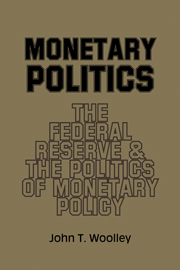Book contents
- Frontmatter
- Contents
- Preface
- 1 The Federal Reserve and the Politics of Monetary Policy: Introduction and Overview
- 2 A Capsule History of the Federal Reserve System
- 3 Recruitment and Selection of Federal Reserve Personnel
- 4 Bankers and the Federal Reserve
- 5 Economists and the Federal Reserve
- 6 The President and the Federal Reserve
- 7 Congress and the Federal Reserve
- 8 Making Monetary Policy in a Political Environment: The Election of 1972
- 9 Monetary Politics: A Summary
- Appendix A A Note on Data Sources
- Appendix B Legislation Included in Table 7.1
- Appendix C Academic Backgrounds and Career Experiences of Notable Monetarists
- Notes
- Bibliographic Note
- Index
8 - Making Monetary Policy in a Political Environment: The Election of 1972
Published online by Cambridge University Press: 01 June 2011
- Frontmatter
- Contents
- Preface
- 1 The Federal Reserve and the Politics of Monetary Policy: Introduction and Overview
- 2 A Capsule History of the Federal Reserve System
- 3 Recruitment and Selection of Federal Reserve Personnel
- 4 Bankers and the Federal Reserve
- 5 Economists and the Federal Reserve
- 6 The President and the Federal Reserve
- 7 Congress and the Federal Reserve
- 8 Making Monetary Policy in a Political Environment: The Election of 1972
- 9 Monetary Politics: A Summary
- Appendix A A Note on Data Sources
- Appendix B Legislation Included in Table 7.1
- Appendix C Academic Backgrounds and Career Experiences of Notable Monetarists
- Notes
- Bibliographic Note
- Index
Summary
The preceding chapters have examined the setting in which the Federal Reserve operates. We have seen how the System interacts with other actors and the factors that condition those interactions. This chapter focuses on the System's response to its environment in 1972. The case of monetary policy in that year is an especially interesting one, for some have suggested, and many have accepted as true, that Federal Reserve policy during 1972 had a clearly partisan motivation. The most frequently cited source of these allegations is an article by Sanford Rose, a well-known and respected economic writer, published in July 1974 in Fortune magazine. In the opening sentences, Rose bluntly defined the issue: “One of the controversies swirling around the battered Nixon Administration has been of special interest to the economics profession. The issue, in brief, is whether the Federal Reserve Board went on a ‘monetary binge’ in 1972 in order to guarantee President Nixon's reelection.” After devoting over five pages to the argument that monetary growth had been excessive during 1972, Rose answered his own question in the affirmative: yes, policy had been shaped for partisan purposes.
Burns's arguments, [for continued stimulus throughout 1972] were impressive, but not impressive enough to sway the FOMC. …
In the circumstances, the dispute between Burns and the FOMC majority became fairly tense at times. At one point, frustrated at his inability to convince the committee of the need to hold down interest rates, Burns left a meeting in obvious anger. […]
- Type
- Chapter
- Information
- Monetary PoliticsThe Federal Reserve and the Politics of Monetary Policy, pp. 154 - 180Publisher: Cambridge University PressPrint publication year: 1984



